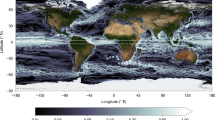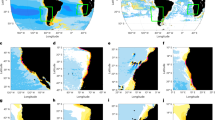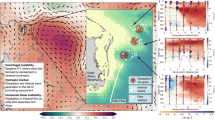Abstract
Eddies and other mesoscale oceanic processes, such as fronts, can enhance biological production in the ocean, according to several open-ocean studies. The effect is thought to be particularly pronounced in low-nutrient environments, where mesoscale processes increase the net upward flux of limiting nutrients. However, eddies have been suggested to suppress production in the highly productive eastern boundary upwelling systems. Here, we examine the relationship between satellite-derived estimates of net primary production, of upwelling strength, and of eddy-kinetic energy—a measure of the intensity of mesoscale activity—in the four most productive eastern boundary upwelling systems. We show that high levels of eddy activity tend to be associated with low levels of biological production, indicative of a suppressive effect. Simulations using eddy-resolving models of two of these upwelling systems support the suggestion that eddies suppress production, and show that the downward export of organic matter is also reduced. According to these simulations, the reduction in production and export results from an eddy-induced transport of nutrients from the nearshore environment to the open ocean. Eddies might have a similar effect on marine productivity in other oceanic systems that are characterized by intense eddy activity, such as the Southern Ocean.
This is a preview of subscription content, access via your institution
Access options
Subscribe to this journal
Receive 12 print issues and online access
$259.00 per year
only $21.58 per issue
Buy this article
- Purchase on Springer Link
- Instant access to full article PDF
Prices may be subject to local taxes which are calculated during checkout




Similar content being viewed by others
References
Falkowski, P. G., Barber, R. T. & Smetacek, V. Biogeochemical controls and feedbacks on ocean primary production. Science 281, 200–206 (1998).
Gruber, N. & Sarmiento, J. L. in THE SEA: Biological–Physical Interactions in the Oceans Vol. 12 (eds Robinson, A. R., McCarthy, J. J. & Rothschild, B. J.) 337–399 (Wiley, 2002).
Williams, R. G. & Follows, M. J. in Ocean Biogeochemistry (ed. Fasham, M. J. R.) Ch. 2, 19–51 (Springer, 2003).
Sarmiento, J. L. & Gruber, N. Ocean Biogeochemical Dynamics (Princeton Univ. Press, 2006).
Falkowski, P. G., Laws, E. A., Barber, R. T. & Murray, J. W. in Ocean Biogeochemistry (ed. Fasham, M. J. R.) Ch. 4, 99–121 (Springer, 2003).
Jenkins, W. J. Nitrate flux into the euphotic zone near Bermuda. Nature 331, 521–523 (1988).
Falkowski, P. G., Ziemann, D., Kolber, Z. & Bienfang, P. K. Role of eddy pumping in enhancing primary production in the ocean. Nature 352, 55–58 (1991).
McGillicuddy, D. J. et al. Influence of mesoscale eddies on new production in the Sargasso Sea. Nature 394, 263–266 (1998).
Oschlies, A. & Garçon, V. Eddy-induced enhancement of primary production in a model of the North Atlantic Ocean. Nature 394, 266–269 (1998).
McGillicuddy, D. J., Anderson, L. A., Doney, S. C. & Maltrud, M. E. Eddy-driven sources and sinks of nutrients in the upper ocean: Results from a 0.1° resolution model of the North Atlantic. Glob. Biogeochem. Cycles 17, 1035 (2003).
McGillicuddy, D. J. et al. Eddy/wind interactions stimulate extraordinary mid-ocean plankton blooms. Science 316, 1021–1026 (2007).
Benitez-Nelson, C. R. et al. Mesoscale eddies drive increased silica export in the subtropical Pacific Ocean. Science 316, 1017–1021 (2007).
Oschlies, A. Model-derived estimates of new production: New results point toward lower values. Deep Sea Res. II 48, 2173–2197 (2001).
Flierl, G. & McGillicuddy, D. J. in THE SEA: Biological-Physical interactions in the Sea Vol. 12 (eds Robinson, A. R., McCarthy, J. J. & Rothschild, B. J.) Ch. 4, 113–185 (Wiley, 2002).
Rossi, V., Lopez, C., Sudre, J., Hernandez-Garcia, E. & Garçon, V. Comparative study of mixing and biological activity of the Benguela and Canary upwelling systems. Geophys. Res. Lett. 35, L11602 (2008).
Rossi, V. et al. Surface mixing and biological activity in the four Eastern boundary upwelling systems. Nonlinear Process. Geophys. 16, 557–568 (2009).
Pauly, D. & Christensen, V. Primary production required to sustain global fisheries. Nature 374, 255–257 (1995).
Fréon, P., Barrange, M. & Aristegui, J. Eastern boundary upwelling ecosystems: Integrative and comparative approaches. Progr. Oceanogr. 83, 1–14 (2009).
Thomas, A. C. Seasonal distribution of satellite-measured phytoplankton pigment concentration along the Chilean coast. J. Geophys. Res. 104, 25877–25890 (1999).
Correa-Ramirez, M. A., Hormazábal, S. & Yuras, G. Mesoscale eddies and high chlorophyll concentrations off central Chile (29° S–39° S). Geophys. Res. Lett. 34, L12604 (2007).
Barber, R. T. & Smith, R. L. in Analysis of Marine Ecosystems (ed. Longhurst, A. R.) 31–68 (Academic, 1981).
Carr, M-E. Estimation of potential productivity in eastern boundary currents using remote sensing. Deep Sea Res. II 49, 59–80 (2002).
Carr, M-E. & Kearns, E. J. Production regimes in four eastern boundary current systems. Deep Sea Res. II 50, 3199–3221 (2003).
Chavez, F. P. & Messié, M. A comparison of eastern boundary upwelling ecosystems. Progr. Oceanogr. 83, 80–96 (2009).
Gruber, N. et al. Eddy-resolving simulation of plankton ecosystem dynamics in the California current system. Deep Sea Res. I 53, 1483–1516 (2006).
Lachkar, Z. & Gruber, N. What controls biological productivity in coastal upwelling systems? Insights from a comparative modeling study. Biogeosci. Discuss. 5617–5652 (2011).
Shchepetkin, A. F. & McWilliams, J. C. The regional oceanic modeling system (ROMS): A split-explicit, free-surface, topography-following-coordinate oceanic model. Ocean Modelling 9, 347–404 (2005).
Marchesiello, P., McWilliams, J. C. & Shchepetkin, A. F. Equilibrium structure and dynamics of the California current system. J. Phys. Oceanogr. 33, 753–783 (2003).
Levy, M., Klein, P. & Treguier, A-M. Impact of sub-mesoscale physics on production and subduction of phytoplankton in an oligotrophic regime. J. Mar. Res. 59, 535–565 (2001).
Capet, X., Colas, F., McWilliams, J., Penven, P. & Marchesiello, in Ocean Modeling in an eddying regime (eds Hecht, M. & Hasumi, H.) 131–147 (Geophysical Monograph Series, no. 177, AGU, 2008).
Marchesiello, P. & Estrade, P. Eddy activity and mixing in upwelling systems: A comparative study of Northwest Africa and California regions. Int. J. Earth Sci. 98, 299–308 (2009).
Lee, M-M. & Williams, R. G. The role of eddies in the isopycnic transfer of nutrients and their impact on biological production. J. Mar. Res. 58, 895–917 (2000).
Barth, J. A. et al. Injection of carbon from the shelf to offshore beneath the euphotic zone in the California current. J. Geophys. Res. 107, 3057 (2002).
Bograd, S. J. & Mantyla, A. W. On the subduction of upwelled waters in the California current. J. Mar. Syst. 63, 863–885 (2005).
Aristegui, J. et al. Variability in plankton community structure, metabolism, and vertical carbon fluxes along an upwelling filament (Cape Juby, NW Africa). Progr. Oceanogr. 62, 95–113 (2004).
Torres-Valdés, S. et al. Distribution of dissolved organic nutrients and their effect on export production over the Atlantic Ocean. Glob. Biogeochem. Cycles 23, GB4019 (2009).
Messié, M. et al. Potential new production estimates in four eastern boundary upwelling ecosystems. Progr. Oceanogr. 83, 151158 (2009).
Patti, B. et al. Factors responsible for the differences in satellite-based chlorophyll a concentration between the major upwelling areas. Estuar. Coast. Shelf Sci. 76, 775–786 (2008).
Chase, Z., Strutton, P. G. & Hales, B. Iron links river runoff and shelf width to phytoplankton biomass along the U.S. West Coast. Geophys. Res. Lett. 34, L04607 (2007).
Pasquero, C., Bracco, A. & Provenzale, A. Impact of the spatiotemporal variability of the nutrient flux on primary productivity in the ocean. J. Geophys. Res. 110, C07005 (2005).
McWilliams, J. C. in Eddy-Resolving Ocean Modeling (eds Hecht, M. &Hasumi, H.) 5–15 (Geophysical Monograph Series, no. 177, AGU, 2008).
Stammer, D. Global characteristics of ocean variability estimated from regional TOPEX/POSEIDON altimeter measurements. J. Phys. Oceanogr. 27, 1743–1769 (1997).
Bakun, A. Coastal ocean upwelling. Science 247, 198–201 (1990).
Behrenfeld, M. J. & Falkowski, P. G. Photosynthetic rates derived from satellite-based chlorophyll concentration. Limnol. Oceanogr. 42, 1–20 (1997).
Bakun, A. Coastal upwelling indices, west coast of North America, 1946–71. NOAA Tech. Rep. NMFS SSRF-671, U.S. Dept. of Commerce (1973).
Yelland, M. & Taylor, P. K. Wind stress measurements from the open ocean. J. Phys. Oceanogr. 26, 541–558 (1996).
Volkov, D. L., Larnicol, G. & Dorandeu, J. Improving the quality of satellite altimetry data over continental shelves. J. Geophys. Res. 112, C06020 (2007).
Acknowledgements
This work was supported financially by ETH Zürich, by the FP7 project CarboChange (Project reference 264879), by the National Aeronautics and Space Agency (NASA-NNG04GJ89G), and by the US National Science Foundation (NSF-ITR and NSF-ICRR). We also thank the Center for Climate Systems Modelling (C2SM) for support. We are grateful to N. Lovenduski for providing us with high-resolution satellite-based climatologies of surface winds and primary production. The EKE product was produced by SSALTO/DUACS as part of the Environment and Climate European Enact project (EVK2-CT2001-00117) and distributed by AVISO, with support from CNES.
Author information
Authors and Affiliations
Contributions
N.G. designed the study, co-analysed the data, and wrote the paper. Z.L. assisted in the design of the study, performed most of the experiments, and led the data analyses. H.F. and T.N. ran earlier experiments and assisted in the analyses. P.M., J.C.M., G.K.P. and M.M. provided conceptual and theoretical advice with regard to design and analyses. All authors discussed the results and implications and commented on the manuscript at all stages.
Corresponding authors
Ethics declarations
Competing interests
The authors declare no competing financial interests.
Supplementary information
Supplementary Information
Supplementary Information (PDF 24558 kb)
Rights and permissions
About this article
Cite this article
Gruber, N., Lachkar, Z., Frenzel, H. et al. Eddy-induced reduction of biological production in eastern boundary upwelling systems. Nature Geosci 4, 787–792 (2011). https://doi.org/10.1038/ngeo1273
Received:
Accepted:
Published:
Issue Date:
DOI: https://doi.org/10.1038/ngeo1273
This article is cited by
-
Cross-shore transport and eddies promote large scale response to urban eutrophication
Scientific Reports (2024)
-
Southern hemisphere eastern boundary upwelling systems emerging as future marine heatwave hotspots under greenhouse warming
Nature Communications (2023)
-
Geostrophic flows control future changes of oceanic eastern boundary upwelling
Nature Climate Change (2023)
-
Regional and global impact of CO2 uptake in the Benguela Upwelling System through preformed nutrients
Nature Communications (2023)
-
Assessment of the Canary current upwelling system in a regionally coupled climate model
Climate Dynamics (2022)



